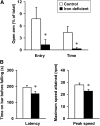Severe postnatal iron deficiency alters emotional behavior and dopamine levels in the prefrontal cortex of young male rats
- PMID: 22013197
- PMCID: PMC3223871
- DOI: 10.3945/jn.111.145946
Severe postnatal iron deficiency alters emotional behavior and dopamine levels in the prefrontal cortex of young male rats
Abstract
Iron deficiency in early human life is associated with abnormal neurological development. The objective of this study was to evaluate the effect of postnatal iron deficiency on emotional behavior and dopaminergic metabolism in the prefrontal cortex in a young male rodent model. Weanling, male, Sprague-Dawley rats were fed standard nonpurified diet (220 mg/kg iron) or an iron-deficient diet (2-6 mg/kg iron). After 1 mo, hematocrits were 0.42 ± 0.0043 and 0.16 ± 0.0068 (mean ± SEM; P < 0.05; n = 8), liver nonheme iron concentrations were 2.3 ± 0.24 and 0.21 ± 0.010 μmol/g liver (P < 0.05; n = 8), and serum iron concentrations were 47 ± 5.4 and 23 ± 7.1 μmol/L (P < 0.05; n = 8), respectively. An elevated plus maze was used to study emotional behavior. Iron-deficient rats displayed anxious behavior with fewer entries and less time spent in open arms compared to control rats (0.25 ± 0.25 vs. 1.8 ± 0.62 entries; 0.88 ± 0.88 vs. 13 ± 4.6 s; P < 0.05; n = 8). Iron-deficient rats also traveled with a lower velocity in the elevated plus maze (1.2 ± 0.15 vs. 1.7 ± 0.12 cm/s; P < 0.05; n = 8), behavior that reflected reduced motor function as measured on a standard accelerating rotarod device. Both the time on the rotarod bar before falling and the peak speed attained on rotarod by iron-deficient rats were lower than control rats (156 ± 12 vs. 194 ± 12 s; 23 ± 1.5 vs. 28 ± 1.6 rpm; P < 0.05; n = 7-8). Microdialysis experiments showed that these behavioral effects were associated with reduced concentrations of extracellular dopamine in the prefrontal cortex of the iron-deficient rats (79 ± 7.0 vs. 110 ± 14 ng/L; P < 0.05; n = 4). Altered dopaminergic signaling in the prefrontal cortex most likely contributes to the anxious behavior observed in young male rats with severe iron deficiency.
Conflict of interest statement
Author disclosures: Y. Li, J. Kim, P. D. Buckett, M. Böhlke, T. J. Maher, and M. Wessling-Resnick, no conflicts of interest.
Figures


Similar articles
-
Persistent neurochemical and behavioral abnormalities in adulthood despite early iron supplementation for perinatal iron deficiency anemia in rats.Behav Brain Res. 2006 Aug 10;171(2):261-70. doi: 10.1016/j.bbr.2006.04.001. Epub 2006 May 19. Behav Brain Res. 2006. PMID: 16713640 Free PMC article.
-
Early iron deficiency alters sensorimotor development and brain monoamines in rats.J Nutr. 2007 Jan;137(1):118-24. doi: 10.1093/jn/137.1.118. J Nutr. 2007. PMID: 17182811
-
Iron-responsive olfactory uptake of manganese improves motor function deficits associated with iron deficiency.PLoS One. 2012;7(3):e33533. doi: 10.1371/journal.pone.0033533. Epub 2012 Mar 30. PLoS One. 2012. PMID: 22479410 Free PMC article.
-
Early iron deficiency has brain and behavior effects consistent with dopaminergic dysfunction.J Nutr. 2011 Apr 1;141(4):740S-746S. doi: 10.3945/jn.110.131169. Epub 2011 Feb 23. J Nutr. 2011. PMID: 21346104 Free PMC article. Review.
-
Long-term brain and behavioral consequences of early iron deficiency.Nutr Rev. 2011 Nov;69 Suppl 1(Suppl 1):S43-8. doi: 10.1111/j.1753-4887.2011.00432.x. Nutr Rev. 2011. PMID: 22043882 Free PMC article. Review.
Cited by
-
Iron and mechanisms of emotional behavior.J Nutr Biochem. 2014 Nov;25(11):1101-1107. doi: 10.1016/j.jnutbio.2014.07.003. Epub 2014 Aug 2. J Nutr Biochem. 2014. PMID: 25154570 Free PMC article. Review.
-
Iron Metabolism in Normal and Pathological Pregnancies and Fetal Consequences.Metabolites. 2022 Jan 29;12(2):129. doi: 10.3390/metabo12020129. Metabolites. 2022. PMID: 35208204 Free PMC article. Review.
-
Iron overload induces cerebral endothelial senescence in aged mice and in primary culture in a sex-dependent manner.Aging Cell. 2023 Nov;22(11):e13977. doi: 10.1111/acel.13977. Epub 2023 Sep 7. Aging Cell. 2023. PMID: 37675802 Free PMC article.
-
Accelerated neuronal differentiation toward motor neuron lineage from human embryonic stem cell line (H9).Tissue Eng Part C Methods. 2015 Mar;21(3):242-52. doi: 10.1089/ten.TEC.2013.0725. Epub 2014 Aug 25. Tissue Eng Part C Methods. 2015. PMID: 25036750 Free PMC article.
-
Effect of olfactory manganese exposure on anxiety-related behavior in a mouse model of iron overload hemochromatosis.Environ Toxicol Pharmacol. 2015 Jul;40(1):333-41. doi: 10.1016/j.etap.2015.06.016. Epub 2015 Jun 23. Environ Toxicol Pharmacol. 2015. PMID: 26189056 Free PMC article.
References
-
- Beard JL, Connor JR. Iron status and neural functioning. Annu Rev Nutr. 2003;23:41–58 - PubMed
-
- Lozoff B, Jimenez E, Wolf AW. Long-term developmental outcome of infants with iron deficiency. N Engl J Med. 1991;325:687–94 - PubMed
-
- Lozoff B, Wolf AW, Jimenez E. Iron-deficiency anemia and infant development: effects of extended oral iron therapy. J Pediatr. 1996;129:382–9 - PubMed
-
- Lozoff B, Jimenez E, Hagen J, Mollen E, Wolf AW. Poorer behavioral and developmental outcome more than 10 years after treatment for iron deficiency in infancy. Pediatrics. 2000;105:E51. - PubMed
-
- Kwik-Uribe CL, Golub MS, Keen CL. Chronic marginal iron intakes during early development in mice alter brain iron concentrations and behavior despite postnatal iron supplementation. J Nutr. 2000;130:2040–8 - PubMed
Publication types
MeSH terms
Substances
Grants and funding
LinkOut - more resources
Full Text Sources
Research Materials
Miscellaneous

